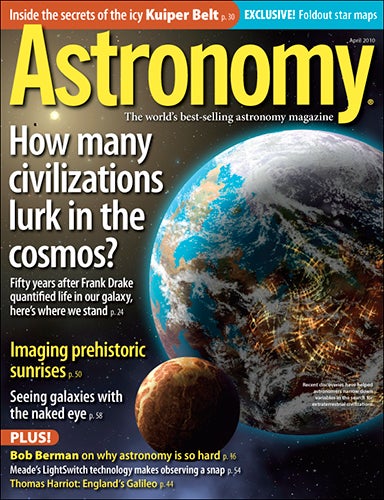
WAUKESHA, Wis. — Fifty years ago, astronomer Frank Drake began the search for intelligent life on other worlds. In order to better comprehend the odds of succeeding in this quest, he devised an equation for estimating how many communicating civilizations might exist in the galaxy. The equation is based on seven parameters, which scientists still use today in this ongoing hunt.
In “How many civilizations lurk in the cosmos?” Astronomy Contributing Editor Steve Nadis details each of the seven parts of the Drake Equation and the best estimates for these numbers today.
Although all but one number were a complete mystery 50 years ago, Nadis writes, “now researchers are making advances on multiple fronts — a testament to achievements in astronomy, planetary science, origin of life research, and investigations into the evolution of intelligence.”
To learn more about the Drake Equation and the odds of extraterrestrial life in our galaxy, pick up the April issue of Astronomy, on newsstands March 2.
“Secrets of the Kuiper Belt”
On February 18, 1930, astronomer Clyde Tombaugh made the discovery of a lifetime when he located an object lurking in the solar system beyond Neptune, now known as Pluto. Today, planetary astronomers have found a vast tally of other trans-Neptunian objects making up what is collectively called the Kuiper Belt. In “Secrets of the Kuiper Belt,” S. Alan Stern, the principal investigator of NASA’s New Horizons mission that will visit Pluto and the Kuiper Belt this decade, explains how the frigid edge of our planetary zone has launched a revolution in understanding the solar system’s origin and evolution.
“Imaging prehistoric sunrises”
Historians have discovered markers all over the world that they agree past cultures created to indicate solstices and equinoxes for use in ceremonies. In “Imaging prehistoric sunrises,” astrophotographer Frank Zullo describes how he used detective work and graphic manipulation to visualize sunrises from a Hohokam solstice site in Phoenix.
April night-sky events visible without optical aid
April 8: Venus points to Mercury, which makes its best evening appearance for the year for Northern Hemisphere observers.
April 11: A waning crescent Moon passes north of Jupiter in the evening twilight.
April 22: The Lyrid meteor shower peaks.
Also in the April 2010 Astronomy
- “Who was Thomas Harriot?” — England’s contemporary of Galileo observed the Sun, the Moon, and Jupiter’s satellites through an early telescope.
- “Meade’s LightSwitch technology makes observing a snap” — This new go-to scope takes the hassle out of setup and offers high-quality optics to boot.
- “The Sky This Month” — Exclusive pullout star charts will guide you through April’s night sky.
- The April issue of Astronomy also includes Astro News, Beautiful Universe, Bob Berman’s Strange Universe, Glenn Chaple’s Observing Basics, David Levy’s Evening Stars, Stephen James O’Meara’s Secret Sky, Ask Astro, Astro Confidential, Deep-sky Showcase, Telescope Insider, The Cosmic Grid, New Products, and Reader Gallery.









